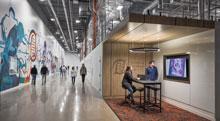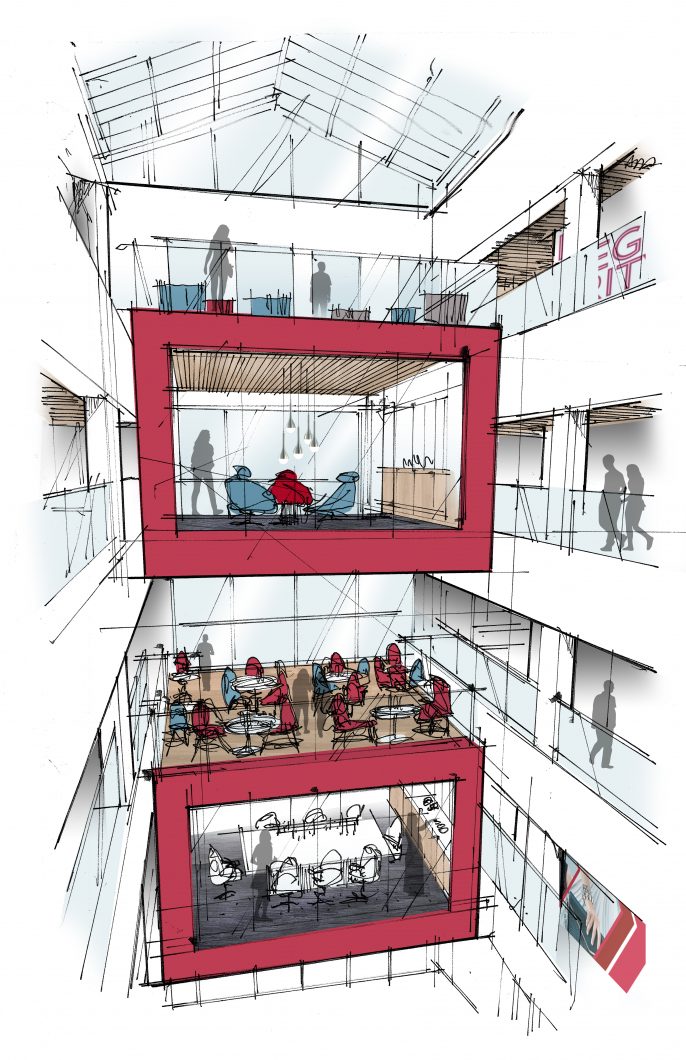
Five Futures For The Post-COVID-19 Workplace

Confined vertical circulation will be the option of last resort.
Work design and real estate professionals (along with everyone else) have fervently dissected the pandemic along with possible responses for corporate real estate post-COVID-19 and presumptive return to workplace scenarios over the last two months. Not surprisingly, questions beget questions. Practical recommendations have been delivered alongside fanciful gimmicks. It is tough to discern the difference, let alone keep up with the volume and pace of content. At this point, despite the opportunistic imaginings of a few, and thanks to the hard work, collaboration, and transparency of thousands, the future direction has become more obvious: In the end, it is the leadership teams who must address the following questions prior to considering a substantial return in force:
- Who ultimately needs to return to the workplace?
- When can a safe and productive return be ensured?
- How will businesses support the physical and psychological well-being of the workforce?
- Does the increase in productivity substantially offset any additional operational or infrastructural expenses we might incur?
- Are we willing to take on the risk?
No easy answers
Unfortunately, there are no easy answers. We know because over the course of the last month, BHDP Architecture has led over 100 leaders of corporate real estate organizations through a series of highly interactive virtual discussions where these questions were candidly addressed amongst peers. The most prepared identified four-step plans with eight embedded sub-phases per step. Others candidly and humbly admit, “we don’t really know.” Whether you are the leader of a regional bank, the director of workplace experience for an international performance apparel company, or the program lead for a federal agency, one reality is clear. Despite our best attempts to discover what the future workplace entails, more questions emerge:
- Have we proven that remote working works just fine?
- How have our workflows collectively shifted as a result of this shared experience?
- What will be left of the workplace when this is all over?
- What does the physical workplace provide that the virtual just can’t?
In an effort to push past “it might,” “it could,” and “it seems,” we encouraged this group to force the issue and collectively imagine five future scenarios for the post-COVID-19 workplace. What follows is not a set of solutions, but rather a series of premises spurred by rapid ideation and supported by authentic dialogue.
Five considerations for a post-COVID-19 workplace
Scenario 1: Past is Prologue.
What if the future looks more like the past? Social distancing at the office worked pretty well when we all had four walls and a door, right? While this is the least cost-effective scenario, returning to a space that nostalgically mimics the workplace of yesteryear certainly has some advantages. Employees are granted privacy, control, and perhaps most importantly, a safe harbor away from the distractions of working from home! However, reverting to antiquated models when technology, processes, and collective preferences have largely obsolesced these spaces seems both expensive and unrealistic. While it might garner headlines that appeal to the luddites amongst us, very few organizations will turn the clocks back in response to the pandemic. Ultimately, these models are just too costly, and investors will not foot the bill.
Scenario 2: Sanitation and Safety.
What if we need to persist in this manner indefinitely? The health, safety, and wellness challenges presented by the coronavirus have forced many corporate real estate executives to acknowledge the limits of our domain expertise. Few if any of us are doctors, scientists, or public health officials. Business interests in returning to the workplace take a backseat over concerns about the threat to the health and well-being of the workforce. The harsh reality is, although state and local governments are putting plans in place to re-open the economy, private sector entities maintain the autonomy to determine when and how a return will occur. For most, there is no plan to get to 100% anytime soon. At best, organizations are considering bringing 20-25 percent of their workforce back during phase one and the threat of an immediate return to phase zero would linger. Much has been written about the important work of maintaining safe, clean workplaces for this group of people. It will require a combination of protocols and operational investments to support distancing, circulation, and cleaning. Additional work is required to promote and maintain shared responsibility, build confidence, and secure trust. Less has been written about the 75-80 percent of the workforce that will remain remote indefinitely. Historically, the majority of the workforce was co-located and the minority distant. The balance, for the foreseeable future, has inverted.

While concentration is best performed in isolation, the pandemic has highlighted the social value of the workplace.
Scenario 3: Catch the Culture.
Where does the heart of the organization beat? For years, the gravity of the workplace conversation has revolved around the dyad of culture and employee experience. The fleeting novelty of working from home quickly revealed that a distributed workforce spends more time staring into an endless stream of chat windows and less time connecting with the people in the boxes on the screen. There are too many downsides to distributed work to continue it indefinitely: managing and mentoring are compromised, technology is still a hindrance, there are only so many virtual meetings a person can endure a day, our homes weren’t designed for this, and we miss each other. The pandemic has clearly demonstrated that the workplace is a better vehicle for social interaction than its virtual counterpart. On the heels of the crisis, many leaders of corporate real estate post-COVID-19 foresee a renewed interest in cracking the code on employee experience. The most alluring model combines a workforce with the skills and technology to work from anywhere with a series of centralized real estate holdings that are appealing enough to encourage periodic “on-sites” to “catch the culture.”
Scenario 4: No Seat. No Problem.
If we have proven that work can happen anywhere, can we finally
operationalize activity-based work? To the perpetually optimistic, the pandemic has finally shattered long-held assumptions about the nature and necessity of a dedicated seat at the office. Employees have struggled for years with the competing demands for both focus and collaboration when assigned to an area that is designed for neither. Corporate real estate leaders have wrestled with the unit economics of allocating scarce resources to underutilized workspaces based on unfounded demands. As organizations strive to maintain earnings and personnel amidst challenging economic conditions, the workplace will be a natural target for reductions. Many organizations have explored alternatives workplace strategies over the last decade. Most have compromised on a model with a modicum of seat-sharing dotted with an underwhelming assortment of furniture settings engineered for specific modes of work. This “middle-ground” will not work in the short-term as density and sharing both run counter to the current state. Organizations that have already adopted a “work everywhere” mindset are best positioned to capitalize on the opportunity ahead.

Open lobby plazas with minimal chokepoints, touchless access, and extensive security surveillance will become the norm.
Scenario 5: Remote Run Rampant.
What if we never return? There are a number of industries where
maintaining a physical footprint is essential, even for knowledge workers. Regulations, information security, and access to specialty technology mean that some sectors simply must return. Other sectors, especially those that rely on a high-degree of informal teaming, have been frankly challenged by maintaining productivity in the current operating environment. With additional investments in technology, home office arrangements, and the occasional return to a scaled-down central hub for periodic check-ins, however, working remote just might work for good. The widespread adoption of remote work would have deep ramifications for the entire fabric of our society. A significant portion of the building supply would become immediately obsolete. Managing networks to secure access to remote talent would become a critical component of every business plan. Structuring tasks for a distributed, gig-based workforce would shift the way that projects are funded, managed and delivered. Infrequent access to workplace settings on a subscription or pay-to-play basis would emerge. In other words, the fusion of the gig-economy on the talent side of the ledger and the sharing-economy on the asset side would transform business operations entirely. As such, market leadership would rely on a combination of technical prowess and social awareness, and the workplace environment would embed itself more deeply and less distinctly in the fabric of our culture.
The future is remote and connected
Leaders in corporate real estate agree. The last ten years of workplace design has centered on striking the right balance between the competing demands for focus and collaboration. The defining question of this decade will be how do we balance the contradictory demands of a remote workforce that is still wired to thrive on physical connection? The spaces we deliver must shift accordingly.
This article was originally published in Work Design Magazine.

